Generative AI Gaining Traction Amid Skepticism, Investment Peaks and Future Prospects
New York, May 22, 2023 (GLOBE NEWSWIRE) — Generative AI Statistics: Since 2022, creativity has experienced rapid technological progress. Generative Artificial Intelligence (AI) is an exciting fad that has quickly spread through the web and made available for sale online. “Generative AI,” as it’s more commonly known, refers to computers and algorithms which use deep learning techniques to produce music, art and other creative outputs according to user requests. Since 2022 the field of creativity has seen rapid technological evolution.
AI (artificial intelligence) is an exciting and promising phenomenon that has taken hold across the Internet in recent years, now available online for accessing. “Generative AI,” as its name suggests, refers to algorithms and computers which employ deep learning for creating art, music and other creative outputs at the request of users. Generative Artificial Intelligence, also known as GANs, is an advanced type of machine learning. Each generative AI produces creative pieces based on user inputs and large volumes of data sets fed to it. Midjourney Dall-E and ChatGPT were among the most beloved examples in 2022 developed by OpenAI; both companies backed by Microsoft as rapidly expanding companies with rapid expansion plans.
Generative AI Statistics Editor’s Choice
- AI-powered search is interesting to 49% of US adults.
- In the United States, 31% of respondents are skeptical of AI-powered search results.
- Despite the current economic concerns, 63 percent of business leaders intend to boost or maintain AI spending.
- Sixty-one percent of respondents (Global Audience) are skeptical about artificial intelligence (AI) technologies.
- Darktrace security researchers found a 135% spike in social engineering attack emails in the first two months of 2023.
- Eighty-two percent of employees are concerned about hackers using generative AI to send phishing emails.
- Americans who are aware of AI-generated news articles such as those from ChatGPT saw it as a large advance, a medium advance, and no advance at all.
- VC firms invested $1.7 billion or more in generative AI across three years, with AI medicine discovery and software development garnering the greatest funding.
- By 2025, generative AI approaches will be used to develop more than 30% of newly found pharmaceuticals and materials, up from 0% now. ChatGPT and other early AI models attempt to improve creative work.
- Artificial intelligence will be responsible for 30% of large organizations’ outbound marketing messaging by 2025, up from less than 2% in 2022.
- A major blockbuster film is expected to be made in 2030, with AI accounting for 90% of the budget, up from 0% in 2022.
- In the United States, AI may replace 7% of occupations, while it will improve 63% of jobs while leaving 30% unaffected.
- From 2018 to 2022, the most often used categories in Generative AI were interfaces using natural language or 2D-media production, accounting for 29.3% and 18.8% of VC-backed deals, respectively, and 23.6% and 11.4% of total invested dollars.
- When it comes to AI content, 35% of marketers see concerns with ‘risk’ and ‘governance’ as a challenge.
- In the United States, 56% of adults believe AI-generated material is biased or deceptive.
- AI in the workplace can save both time and money, according to 62% of US adults.
- According to 47% of US adults, AI should replace unnecessary tasks at work in order to increase efficiency and production.
- 43% of adult workers in the United States feel AI-generated written content may be as excellent as human-authored content.
Generative AI Use Cases for Marketers
- ChatGPT, word, Jasper, Copy.ai, Frase, and Quillbot are among the AI technologies used by 58.9% of marketers to optimize current content.
- 57.1% of firms utilize artificial intelligence tools to create long-form content (blogs, white papers, and eBooks).
- 55.4% of marketers use artificial intelligence tools to create short-form content for social media and product descriptions.
- 48.2% of marketers use Generative AI tools to generate future content ideas.
- 46.4% of marketers use Generative AI to generate long-form content headlines, while 44.5% use it for keyword research.
- According to 88% of marketers, using Generative AI saves their firm time and money.
- According to 88% of marketers, AI content is as good as or better than human content.
Global artificial intelligence market size 2021-2030
The artificial intelligence industry has grown significantly in recent years and is likely to increase further in the coming years. AI technologies are being embraced across a wide range of industries and applications, revolutionizing company operations and opening up new avenues for innovation.
Artificial Intelligence for Science, Medical Sciences, and Mental Wellness
- More than half of Americans consider the use of artificial intelligence in operations as a beneficial development. The Pew Research Center is an independent research institution.
- AI-assisted surgery is considered as a big medical advancement by 56% of people who are aware of it, a moderate medical advancement by 22%, and a non-advance by 5%.
- Those who are familiar with artificial intelligence-based skin cancer diagnosis had a positive attitude, with 52% seeing it as a significant medical advancement and 27% seeing it as a modest one.
- When compared to other applications, fewer Americans (30%) believe that AI-assisted pain medicine decisions are major, while 37% believe they are insignificant.
- Among US adults who are aware of mental health chatbots, 19% consider it a major advancement, 36% consider it a small advancement, and 25% do not consider it an advancement.
Rising Industries and Upcoming Trends in Generative AI
Generative AI in Fashion: In 2022, the global generative AI in the fashion market was valued at USD 69 Mn. Between 2023 and 2032, this market is estimated to register the highest CAGR of 36.9% and will reach a valuation of USD 1,481 Mn by 2032.
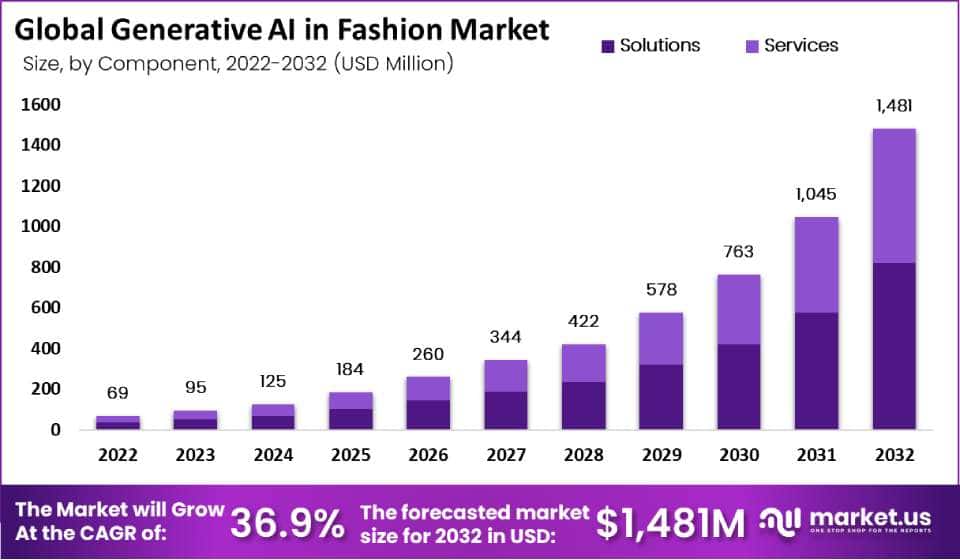
Generative AI in Animation: In 2022, the global generative AI in Animation market was valued at USD 0.9 billion. Between 2023 and 2032, this market is estimated to register the highest CAGR of 35.7% and is expected to reach USD 17.7 billion in 2032. AI can be used for the animation process, such as creating backgrounds, visuals, and environments.
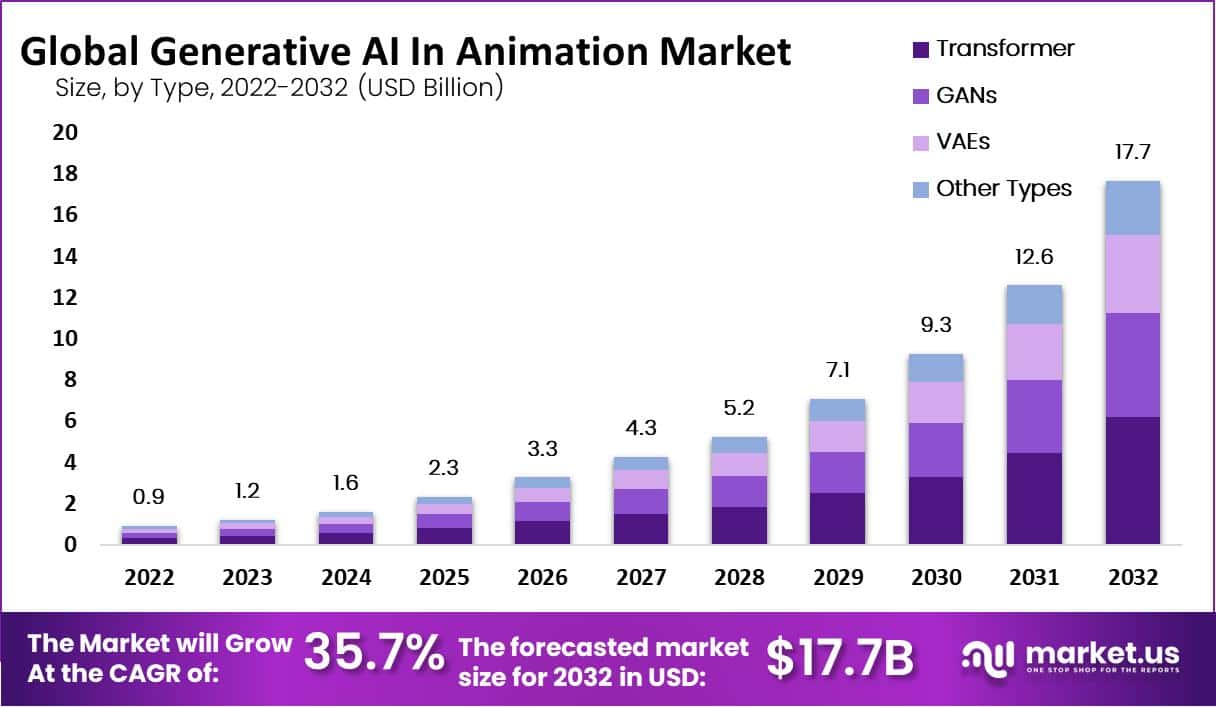
Generative AI in Business: The global Generative AI in Business Market size was valued at USD 1.2 billion in 2022 and is expected to grow at a CAGR of 33.5% during the forecast period of 2023-2032. It is predicted to reach USD 20.9 billion by 2032.
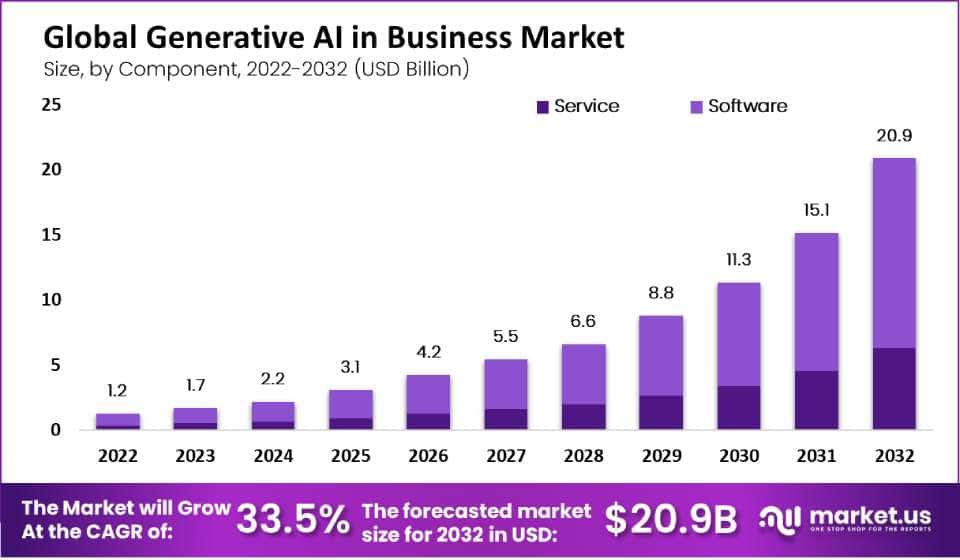
Generative AI in Music: In 2022, the Global Generative AI in the Music Market was valued at USD 229 million. Between 2023 and 2032, this market is estimated to register the highest CAGR of 28.6%. It is expected to reach USD 2,660 million by 2032.
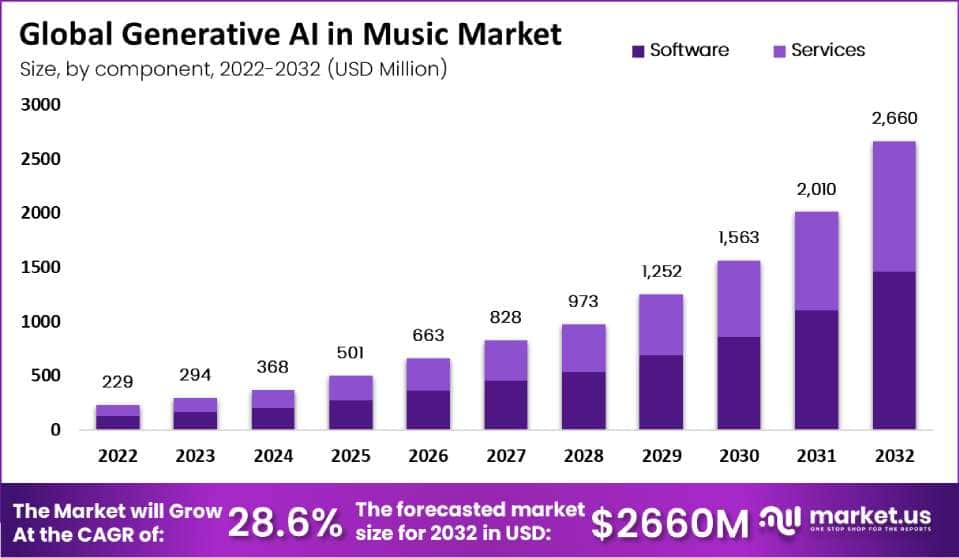
Generative AI in Healthcare: In 2022, the Global Generative AI in Healthcare Market was valued at USD 0.8 billion and is expected to be valued at USD 17.2 billion in 2032. Between 2023 and 2032, this market is estimated to register the highest CAGR of 37.0%.
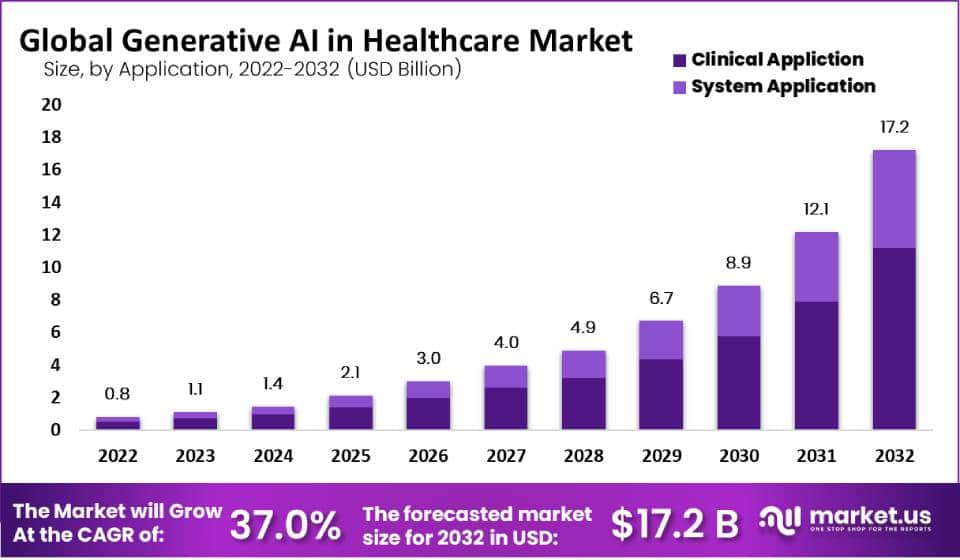
Generative AI in Fintech: Generative AI in Fintech Market will exceed USD 6,256 million by 2032, rising from USD 865 million in 2022. Furthermore, it is anticipated to achieve a Compound Annual Growth Rate (CAGR) of 22.5% between 2023 and 2032.
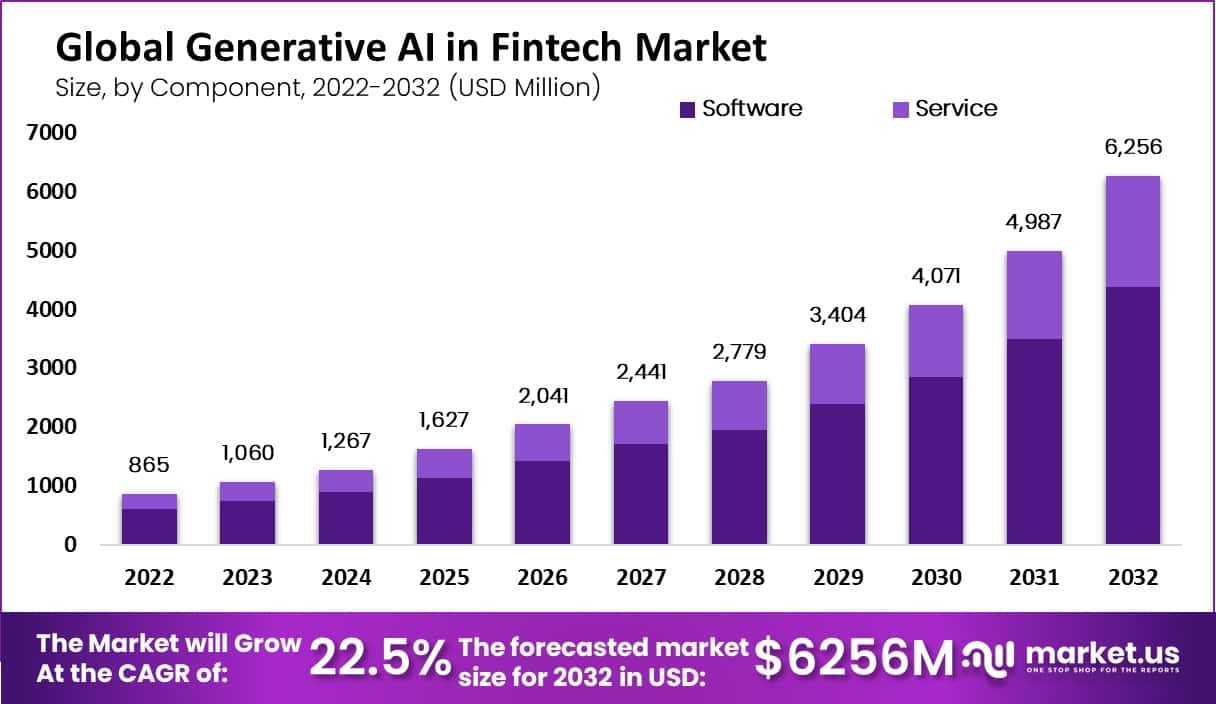
Generative AI in Marketing: In 2022, the Global Generative AI in Marketing Market was valued at USD 1.9 Billion. Between 2023 and 2032, this market is estimated to register the highest CAGR of 28.6%. It is expected to reach USD 22.1 bilion in the forecast period.
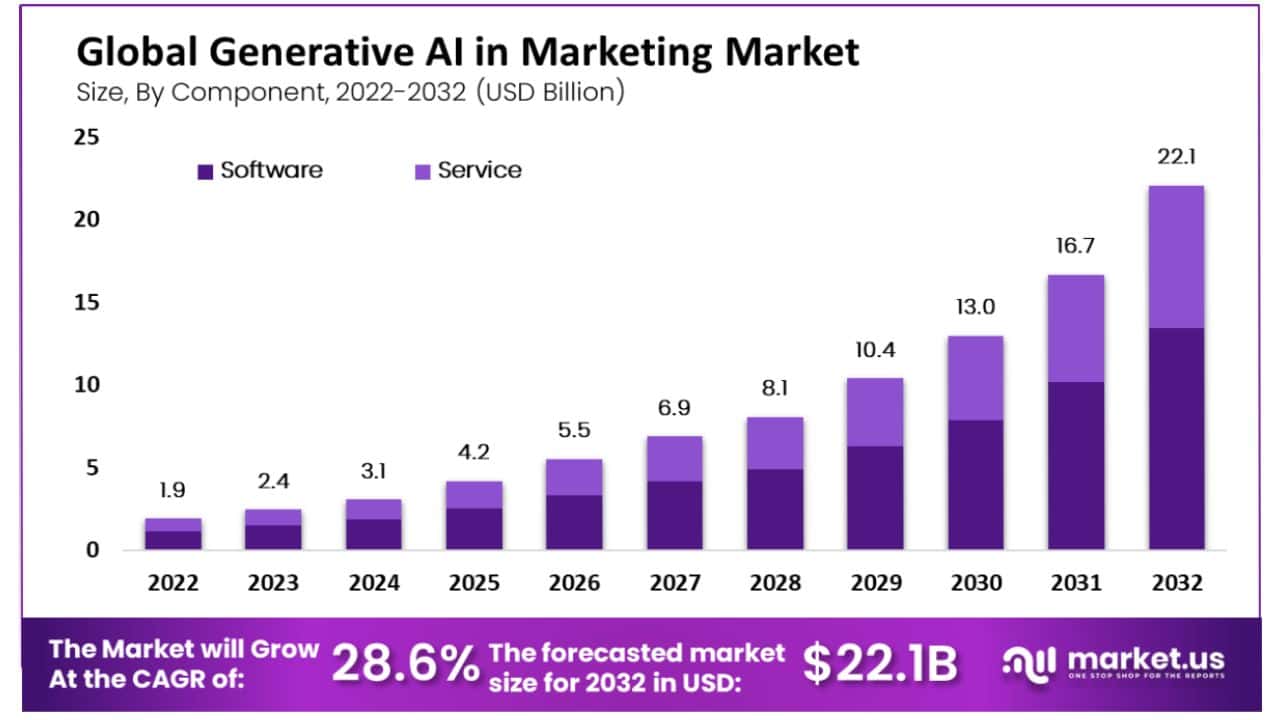
Generative AI in Gaming: In 2022, the Global Generative AI in Gaming Market was valued at USD 922 MN. Between 2023 and 2032, this market is estimated to register the highest CAGR of 23.3%. It is predicted to reach a valuation of USD 7,105 MN by 2032.
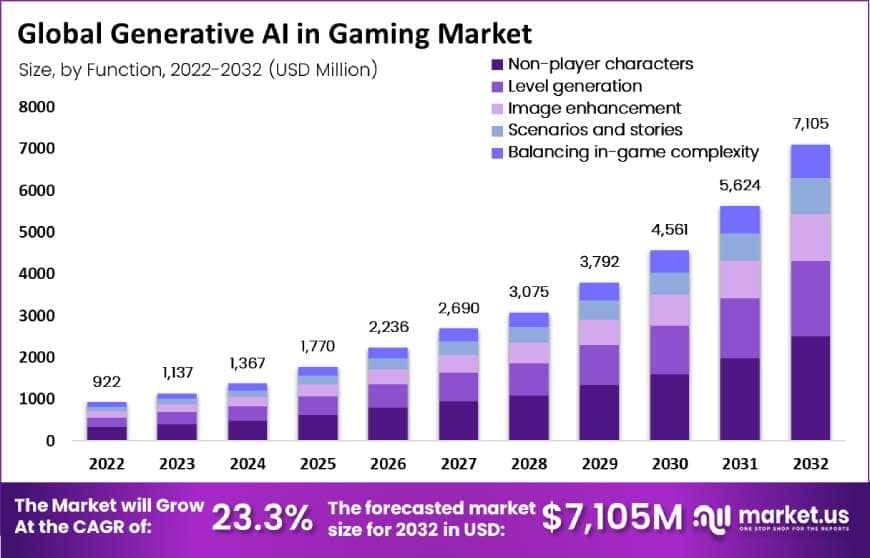
Generative AI in Conference: In 2022, the Global Generative AI in the Conference Market was valued at USD 112.5 million and is expected to reach around USD 588.7 million by 2032. Between 2023 and 2032, this market is estimated to register the highest CAGR of 18.5 %.
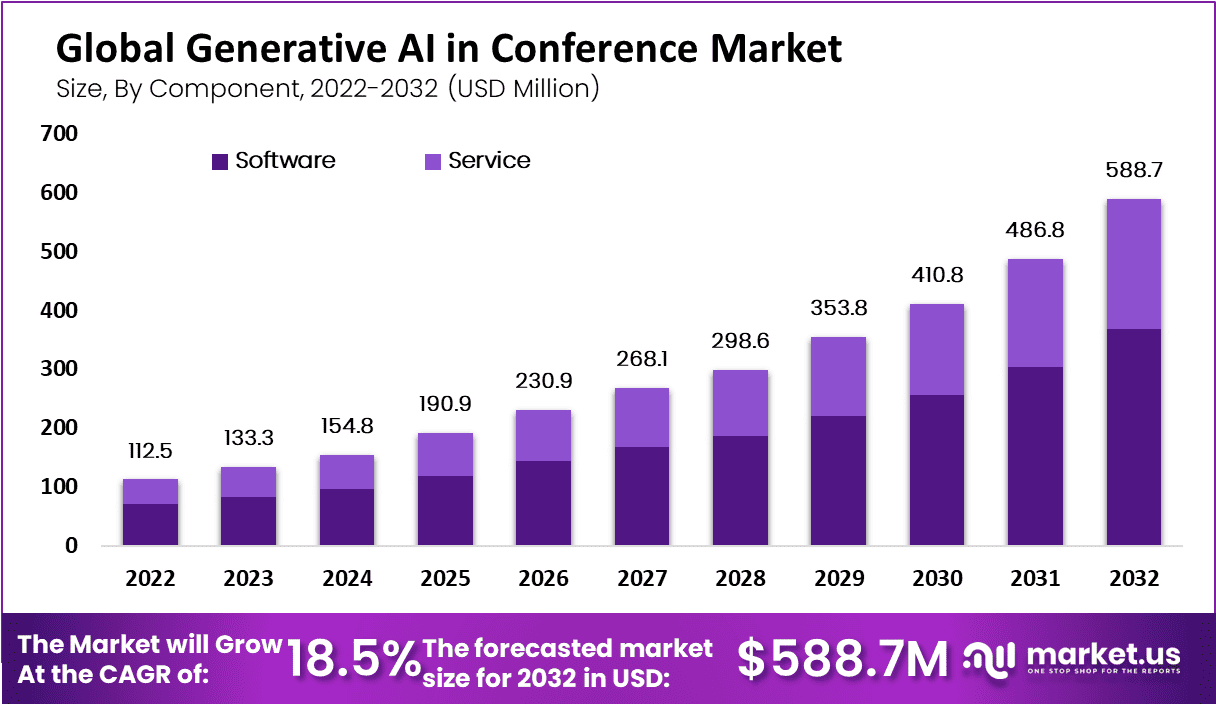
ChatGPT Statistics
- 53% of employees say their firm is now using or planning to use ChatGPT.
- 16% of users utilize ChatGPT, with 59% desiring to use it.
- 35% of clients are unaware of ChatGPT.
- It is useful to 86% of ChatGPT users, who use it for a variety of reasons.
- Telecommunications, insurance, software development, engineering, and management consulting are the top five industries that employ ChatGPT.
- 68% of users utilize ChatGPT to answer questions rather than search engines.
- AI improvements, according to 63% of ChatGPT users, would help improve the workplace.
- Half of ChatGPT users have worries about the influence of AI tools on the creative industry.
- 46% of ChatGPT users are concerned about AI bias.
- 50% of users would pay for ChatGPT’s premium edition.
AI’s Impact on Businesses and Performance
- 78% of customer service employees are optimistic about artificial intelligence (Dialpad).
- According to McKinsey, AI implementation has resulted in cost savings for 79% of executives.
- Ai-enabled contact centers are more than twice as efficient as traditional contact centers (Dialpad).
- Using AI increases company performance, according to 66% of customer service personnel (Dialpad).
- Using Codex, a code-generation tool, Deloitte developers discovered a 20% increase in code development speed (HBR).
Other AI generative stats
- The most popular search engine for ChatGPT is China, followed by Nepal and Singapore (Wired).
- OpenAI’s AI detection software’s classifier can correctly recognize 26% of AI-written text while misunderstanding human-written text as AI-written 9% of the time (OpenAI).
- The GPT-3 language model was created with the help of 175 billion parameters (OpenAI).

AI’s Future Potential
The future of AI is quite exciting, with enormous potential to revolutionize various facets of our life. Here are a few important areas where AI is predicted to have a large future impact:
- Automation: Artificial intelligence will continue to automate repetitive operations across industries, resulting in enhanced efficiency and productivity. Manufacturing, shipping, customer service, and data analysis are all examples of this.
- Healthcare: AI has the potential to transform healthcare by assisting in early disease identification, tailored medicine, and medication discovery. It is capable of analyzing massive volumes of medical data, assisting in diagnosis, and even providing virtual medical aid.
- Autonomous Vehicles: The advancement of self-driving automobiles and other autonomous vehicles is accelerating. AI is critical to these vehicles’ ability to comprehend their environment, make judgments, and travel safely.
- Natural Language Processing: Natural language processing (NLP) systems driven by AI will continue to evolve, allowing for more advanced voice assistants, translation tools, and language understanding skills. This will improve human-computer interaction and help to overcome linguistic hurdles.
- Robotics: Artificial intelligence and robotics are combining to produce smart robots capable of completing complicated tasks. These robots can be used to aid humans in a variety of tasks in areas such as manufacturing, healthcare, agriculture, and even home settings.
- Cybersecurity: As cyber dangers evolve, AI will become increasingly important in detecting and mitigating these risks in real-time. AI-powered cybersecurity solutions can detect patterns, anomalies, and probable breaches, hence improving digital system security.
- Ethical and Responsible AI: Addressing ethical problems and ensuring responsible research and deployment are equally important aspects of AI’s future. To manage AI systems, efforts will be made to minimize biases, preserve openness, safeguard privacy, and develop ethical rules.
- AI-assisted Creativity: Artificial intelligence (AI) techniques are rapidly being used to support and augment human creativity in industries such as art, music, and content creation. AI algorithms can create unique artwork, produce music, and even assist in the creation of articles or books.
About Us:
Market.us Scoop, the premier source for comprehensive, accurate, and unbiased statistics in the rapidly evolving domains of technology, automotive, artificial intelligence, and beyond. Our mission is to empower you with the data and insights you need to make well-informed decisions, stay ahead of the curve, and drive innovation.
Founded in 2017, Market.us Scoop is the brainchild of a group of passionate data enthusiasts, industry experts, and storytellers who understand the transformative power of data. With backgrounds in data science, journalism, and research, our team is dedicated to demystifying complex subjects and making them accessible to all.
At Market.us Scoop, we recognize the importance of data integrity and strive to provide you with the most up-to-date, reliable, and relevant information. We meticulously gather and analyze data from an extensive network of reputable sources, ensuring that our statistics meet the highest standards of accuracy and credibility. Our in-depth reports cover a wide range of topics, including emerging technologies, market trends, consumer behavior, industry analysis, and much more.

For all the latest Life Style News Click Here
For the latest news and updates, follow us on Google News.
